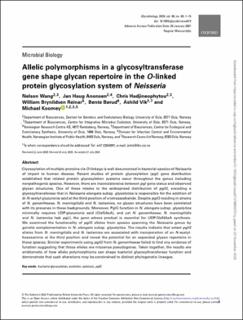| dc.description.abstract | Glycosylation of multiple proteins via O-linkage is well documented in bacterial species of Neisseria of import to human disease. Recent studies of protein glycosylation (pgl) gene distribution established that related protein glycosylation systems occur throughout the genus including nonpathogenic species. However, there are inconsistencies between pgl gene status and observed glycan structures. One of these relates to the widespread distribution of pglG, encoding a glycosyltransferase that in Neisseria elongata subsp. glycolytica is responsible for the addition of di-N-acetyl glucuronic acid at the third position of a tetrasaccharide. Despite pglG residing in strains of N. gonorrhoeae, N. meningitidis and N. lactamica, no glycan structures have been correlated with its presence in these backgrounds. Moreover, PglG function in N. elongata subsp. glycolytica minimally requires UDP-glucuronic acid (GlcNAcA), and yet N. gonorrhoeae, N. meningitidis and N. lactamica lack pglJ, the gene whose product is essential for UDP-GlcNAcA synthesis. We examined the functionality of pglG alleles from species spanning the Neisseria genus by genetic complementation in N. elongata subsp. glycolytica. The results indicate that select pglG alleles from N. meningitidis and N. lactamica are associated with incorporation of an N-acetyl-hexosamine at the third position and reveal the potential for an expanded glycan repertoire in those species. Similar experiments using pglG from N. gonorrhoeae failed to find any evidence of function suggesting that those alleles are missense pseudogenes. Taken together, the results are emblematic of how allelic polymorphisms can shape bacterial glycosyltransferase function and demonstrate that such alterations may be constrained to distinct phylogenetic lineages. | en_US |

